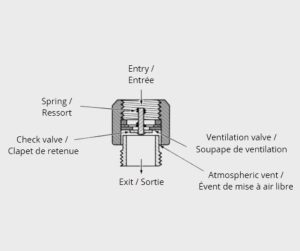HCVB: A small device to avoid big problems!
The HCVB, or Hose Connection Vacuum Breaker, is a small device that plays a crucial role: preventing water from flowing backwards in a system where a hose is connected. In other words, it protects the drinking water supply against the risks of backflow due to siphoning.
This article highlights the importance of the HCVB, as well as the serious consequences that can result from neglect or improper installation.
Why can an unprotected hose be dangerous?
As shown in an article from the City of Lynchburg (https://www.lynchburgva.gov/541/Examples-of-Backflow), real cases of backflow have contaminated drinking water networks with chlordane (a toxic insecticide), wine, or even parasitic worms, simply because unprotected hoses are exposed to pressure fluctuations.
And this can happen anywhere: in private residences, schools, factories, hospitals… or even in your own home.
The remedy: a simple and inexpensive solution
Installing an HCVB is an affordable preventive measure that protects users and water networks against this type of scenario. It is particularly useful on:
- outdoor faucets
- janitorial sinks
… locations where accidental backflow due to siphoning can occur.
However, in accordance with CSA B64.2, the HCVB:
- is not designed for systems under continuous pressure,
- does not protect against back pressure,
- is not field testable.
But for short-term applications, the HCVB provides a simple and compliant solution for all types of risk levels.
A tool that remains relevant for plumbers
Although it does not replace the more robust devices required for high-risk continuous pressure systems, the HCVB remains an essential tool.
It allows for:
- protect certain water points locally,
- add a layer of safety wherever possible,
- reduce installation costs for specific and well targeted uses.
Not all water points present the same level of danger, and that is exactly where the HCVB proves its relevancy.
References:
- Figures are taken from CSA B64.10:23 / CSA B64.10.1.23 and adapted for a bilingual version.


